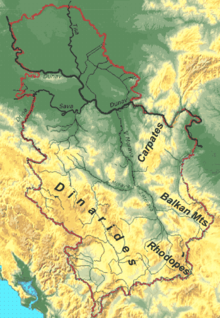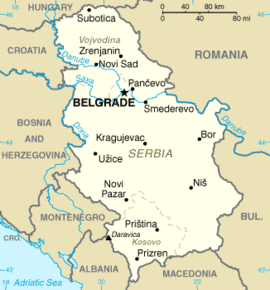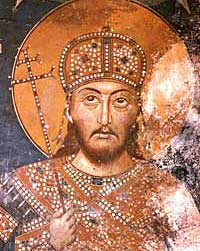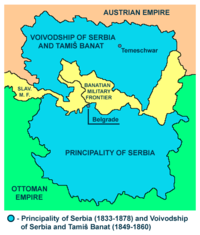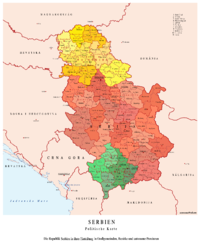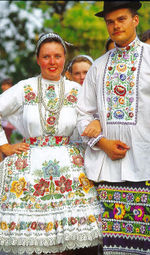Serbia
2007 Schools Wikipedia Selection. Related subjects: Countries; European Countries
| Република Србија Republika Srbija Republic of Serbia |
|||||
|
|||||
| Motto: none | |||||
| Anthem: Bože pravde (English: God of Justice) |
|||||
| Capital (and largest city) |
Belgrade |
||||
| Official languages | Serbian, cyrillic script1 | ||||
|---|---|---|---|---|---|
| Government | Republic | ||||
| - Prime Minister | Vojislav Koštunica | ||||
| - President | Boris Tadić | ||||
| Establishment | |||||
| - Formation | 814 | ||||
| - First Serbian Uprising | 1804 | ||||
| - Internationally recognized | July 13, 1878 | ||||
| - Kingdom of SCS created | December 1, 1918 | ||||
| - SCG dissolved | June 5, 2006 | ||||
| Area | |||||
| - Total | 88,361 km² ( 113th) 34,116 sq mi |
||||
| - Water (%) | n/a | ||||
| Population | |||||
| - 2006 estimate | 9,396,411 ( 83th) | ||||
| - Density | 106/km² ( 94th) 275/sq mi |
||||
| GDP ( PPP) | 2006 estimate | ||||
| - Total | $47,77 billion ( 77th) | ||||
| - Per capita | $5,713 ( 97th) | ||||
| HDI (n/a) | n/a (not ranked) ( n/a) | ||||
| Currency | Serbian dinar2 ( RSD) |
||||
| Time zone | CET ( UTC+1) | ||||
| Internet TLD | .yu ( .rs)3 | ||||
| Calling code | +3814 | ||||
| 1 In Vojvodina, the following languages are also official: Hungarian, Slovak, Romanian, Rusyn and Croatian. In Kosovo, Albanian and English are also official. |
|||||
Serbia, officially the Republic of Serbia ( Serbian: Република Србија or Republika Srbija, listen ), is a landlocked country in Central and Southeastern Europe, covering the central part of the Balkan Peninsula and the southern part of the Pannonian Plain. The capital is Belgrade. Serbia borders Hungary to the north; Romania and Bulgaria to the east; Albania and the Republic of Macedonia to the south; and Montenegro, Croatia and Bosnia and Herzegovina to the west.
Invited by Byzantine emperor Heraclius Serbs settled the region by 630 A.D. , fully converted to Christianity by 865 A.D. , formed three distinct independent kingdoms by the 14th century- in Dioclea , Rascia and Bosnia , as well as two distinct shortlasting Empires- Serbian Empire of Stefan Dusan and Empire of Jovan Nenad . The Medieval Serbian Kingdom, later Empire, rose from Byzantine, Bulgarian and Hungarian patronage to become a threat to the very existence of Constantinople itself.
Placed under Ottoman occupation in the 15th century following the collapse of the Serbian Empire, the uprisings against Turkish occupation between 1804- 1815 reestablished Serbia as a state which obtained formal independence in 1878 . Victorious in Balkan wars and World War I , for nearly a century Serbia was part of various South Slavic states, including the Kingdom of the Serbs, Croats and Slovenes from 1918 to 1941 (renamed to the Kingdom of Yugoslavia in 1929), the Socialist Federal Republic of Yugoslavia from 1945 to 1992, the Federal Republic of Yugoslavia from 1992 to 2003, and the State Union of Serbia and Montenegro from 2003 to 2006 . After Montenegro voted independence from the State Union, Serbia officially proclaimed its independence on June 5, 2006, as the successor state to the State Union of Serbia and Montenegro.
Geography
Serbia is located in the Balkans and in the Pannonian Plain (a region of central Europe). It is placed at the crossroads between Central, Southern and Eastern Europe. Serbian borders and regions are mostly determined by nature itself. Danube river (2850 km) flows through the northern third of the country in length of 588 km, forming the border with Croatia and partially, Romania. Sava river forms the southern border of the Vojvodina province, flowing into the Danube in central Belgrade, while bypassing the hills of the Fruska Gora ("Frankish Mountains") in the west. 60 km to the northeast of Belgrade Tisa river flows into the Danube, ending its 1350 km long journey from Ukraine, with partially navigable Tamis (60 km/350 km) also flowing into the Danube near Pancevo. Begej river (254km) flows into Tisa near Titel. All five rivers are navigable, connecting the country with Northern and Western Europe (through Rhine-Main-Danube Canal - North Sea route); Eastern Europe (via Tisa- Tamis- Begej and Danube- Black sea route); and Southern Europe ( Sava river - 990 km long - connects Belgrade with Zagreb and Ljubljana)- altogether making the strategic importance of Serbia invaluable.
Eastern border of the country is determined by the Carpathian Mountain range, which run through entire Central Europe, separating it from the East. Carpathians meet the Balkan Mountains, following the course of Velika Morava, 500 km long (partially navigable) river. Midzor peak tops Eastern Serbia at 2156 m. In the southeast Balkan Mountains meet the Rhodope Mountains, connecting the country with Greece. Sar Mountains of Kosovo form the border with Albania, with one of the highest peaks in the region- Djeravica {2656 m). Dinaric Alps of Serbia follow the flow of the Drina river -(at 350 km navigable for smaller vessels only)- overlooking the Dinaric peaks on the other side of the shore in Bosnia and Herzegovina.
Climate
The Serbian climate varies between a continental climate in the north, with cold winters, and hot, humid summers with well distributed rainfall patterns, and a more Adriatic climate in the south with hot, dry summers and autumns and relatively cold winters with heavy inland snowfall. Differences in elevation, proximity to the Adriatic sea and large river basins, as well as the exposure to the winds makes the range of climates within Serbia quite obvious . Vojvodina posseses typical continental climate, with airmasses from Northern and Western Europe which shape its climatic profile. South and Southwest Serbia is subject to Mediterranean influences, however the Dinaric Alps and other mountain ranges help in cooling down the biggest part of warm air masses. However traditionally these are the warmest parts of the country during the summer, while winters are quite harsh in Sandzak due to the mountains which encircle that platoue . Morava valley also shows signs of Mediterranean influences due to the "relative proximity" of the Aegean sea (*note that Serbia is a landlocked country).
Cities
Major cities (over 100,000 inhabitants) - 2002 census data, for Kosovo current World Gazetteer estimates (unofficial):
- Beograd (Belgrade): 1,273,651 (inner city area); 1,576,124 (with suburbs)
- Novi Sad: 215,659 (298,139 greater metropolitan area)
- Priština: between 155,499 (1991 census) and 262,686 (2006 calculation)
- Niš: 194,790 (250,518 greater metropolitan area)
- Kragujevac: 147.473 (180.252 greater metropolitan area)
- Prizren: between 92,303 (1991 census) and 165,227 (2006 calculation)
- Subotica: 99,471 (147,758 greater metropolitan area)
National parks
Serbia has five national parks:
- Fruška Gora (250 km²)
- Kopaonik (120 km²)
- Tara (220 km²)
- Đerdap ( Iron Gate) (640 km²)
- Šar-planina (390 km²)
History
Medieval Serbia
The roots of the Serbian state date back to the 7th century and the House of Vlastimirović. A Serbian kingdom (centered around Duklja) was established in the 11th century. It lasted until the end of the 12th century.
The medieval Serbian state was re-formed in the Raška region in the 12th century by the Serbian Grand Župan Stefan Nemanja. In 1220, under Stefan the First Crowned, Serbia became a kingdom, and in 1346, Stefan Dušan established the Serbian Empire. Under a string of accomplished leaders, from Stefan Nemanja, through the Czar Stefan Dusan The Great, and culminating with the death of Prince Lazar at Kosovo in 1389, the medieval Serbs created a political entity which today still resonates strongly in the Serbian culture. The Empire was disintegrated and fell to the Ottoman Turks after the historic Battle of Kosovo in 1389. The northern Serbian territories (the Serbian Despotate) were conquered in 1459 following the siege of the "temporary" capital Smederevo. Bosnia fell a few years after Smederevo, and Herzegovina in 1482. Belgrade was the last major Balkan city to endure Ottoman onslaughts, as it joined Catholic Royal Hungary, following heavy Turkish defeat in Siege of Belgrade of 1456. It held out for another 70 years, succumbing to the Ottomans in 1521, alongside greater part of Hungary that was soon conquered.
Ottoman Serbia
Following the collapse of Serbian Empire in Battle of Kosovo, between 1459 and 1804, Serbia was under the Ottoman occupation, despite three Austrian invasions and numerous rebellions (such as the Banat Uprising). Islam was in a period of expansion during this time, especially in Raska, Kosovo and Bosnia. Many Serbs (and Croats) converted to Islam, which eventually led to the forming of the Bosniak nation. The Ottoman period was a defining one in the history of the country; Slavic, Byzantine, Arabic and Turkish cultures suffused. Many contemporary cultural traits can be traced back to Ottoman period. However the majority of the Serbs managed to keep their culture and religion through the long period of Ottoman rule.
Modern Serbia
The First Serbian Uprising of 1804- 1813, led by Đorđe Petrović (also known as Karađorđe or "Black George"), and the Second Serbian Uprising of 1815 resulted in the establishment of the Principality of Serbia. As it was semi-independent from the Ottoman Empire, it is considered to be the precursor of the formation of modern Serbia.
From 1815 to 1903, the Serbian state was ruled by the House of Obrenović, except from 1842 to 1858, when Serbia was ruled by Prince Aleksandar Karađorđević. In 1903, the House of Obrenović was replaced by the House of Karađorđević, who were descendants of Đorđe Petrović.
In the northern part of present-day Serbia that was ruled by the Austrian Empire, the local Serbs created in 1848 their autonomous region known as the Serbian Vojvodina. The region was in 1849 transformed into new Austrian crownland known as the Vojvodina of Serbia and Tamiš Banat. Although, the crownland was abolished in 1860, the Serbs from the Vojvodina region gained another opportunity to achieve their political demands in 1918.
The struggle for a modern society, human rights and a nation-state in Serbia lasted almost three decades and was completed with the adoption of the constitution on 15th February 1835. In 1876, Montenegro, Serbia, and Bosnia declared war against the Ottoman Empire and proclaimed their unification. However, the Treaty of Berlin of 1878, which was signed at the Congress of Berlin by the Great Powers, granted complete independence only to Serbia and Montenegro, leaving Bosnia and Raška to Austria-Hungary, who blocked their unification until the Balkan Wars of 1912 and 1913 and World War I.
On 28 June 1914 the assassination of Archduke Franz Ferdinand of Austria at Sarajevo in Austria-Hungary by Gavrilo Princip, a South Slav unionist, Austrian citizen and member of Young Bosnia, led to Austria-Hungary declaring war on Serbia. The Russian Empire started to mobilise its troops in defence of its ally Serbia, which resulted in the German Empire declaring war on Russia in support of its ally Austria-Hungary. However, as German military planners wished to avoid a war on two fronts against both Russia and France, they attacked France first. This eventually culminated in all the major European Powers being drawn into the war. The Serbian Army won several major victories against Austria-Hungary at the beginning of World War I, but it was overpowered by the joint forces of the German Empire, Austria-Hungary and Bulgaria in 1915. Most of its army and some people went to exile to Greece and Corfu where it healed, regrouped and returned to Thessaloniki front to lead a final breaktrough through enemy lines on 15 September 1918, freeing Serbia again and ending the war on 11 November. In World War I, Serbia had 1,264,000 casualties — 28% of its total population, and 58% of its male population.
This article is part of the series on the |
|||
| Medieval Serbia | |||
| Raška | |||
| Serbian Empire | |||
| Battle of Kosovo | |||
| Serbian Despotate | |||
| Ottoman Serbia | |||
| First Serbian Uprising | |||
| Second Serbian Uprising | |||
| Modern Serbia | |||
| Principality of Serbia | |||
| Kingdom of Serbia | |||
| Serbian Campaign (World War I) | |||
| Kingdom of Yugoslavia | |||
| Nedić's Serbia | |||
| SFR Yugoslavia | |||
| FR Yugoslavia | |||
| Serbia and Montenegro | |||
| Republic of Serbia | |||
Between the wars
After 1918, Serbia, along with Montenegro, was a founding member of the Kingdom of Serbs, Croats and Slovenes, later known as the Kingdom of Yugoslavia. During World War II, Serbia was a German-occupied puppet state that included present-day Central Serbia and Banat, popularly called Nedić's Serbia. However, parts of the present-day territory of Serbia were occupied by Croatian, Hungarian, Bulgarian, Albanian, and Italian armies. The occupying powers committed numerous crimes against the civilian population, especially against Serbs and Jews.
Post WWII
In 1945, Serbia was established as one of the federal units of the second Yugoslavia, the Socialist Federative Republic of Yugoslavia, led by Josip Broz Tito until his death in 1980.
After the collapse of the second Yugoslavia in 1992 until the year 2003, Serbia, together with Montenegro, was part of the Federal Republic of Yugoslavia. Despite civil wars in neighbouring Croatia and Bosnia and Herzegovina, while helping Serbs in Croatia and Bosnia try to remain a part of Yugoslavia, Serbia remained peaceful until 1998, when clashes with the Kosovo Liberation Army started in Kosovo.
Between 1998 and 1999, continued clashes in Kosovo between Serbian and Yugoslav security forces and the K.L.A. prompted a NATO aerial bombardment which lasted for 78 days. The attacks were stopped when Yugoslav president Slobodan Milošević agreed to remove all security forces, including the military and the police, and have them replaced by a body of international police, in return for which Kosovo would formally remain within the Yugoslav Federation (See: Kosovo War).
In September 2000, opposition parties claimed that Milošević committed fraud in routine federal elections. Street protests and rallies throughout Serbia eventually forced Milošević to concede and hand over power to the recently formed Democratic Opposition of Serbia (DOS), a broad coalition of anti-Milošević parties.
The fall of Milošević led to end of the international isolation Serbia suffered during the Milošević years. Serbia's new leaders announced that Serbia would seek to join the European Union and NATO. In October 2005, the EU opened negotiations with Serbia for a Stabilization and Association Agreement (SAA), a preliminary step towards joining the EU.
From 2003 to 2006, Serbia was part of the State Union of Serbia and Montenegro, into which the Federal Republic of Yugoslavia had been transformed. On May 21, 2006, Montenegro held a referendum to determine whether or not to end the union with Serbia. The next day, state-certified results showed 55.5% of voters in favour of independence, which was just above the 55% required by the referendum. On June 3, the Parliament of Montenegro declared Montenegro independent of the State Union and on June 5, the National Assembly of Serbia declared Serbia the successor to the State Union.
Government and politics
On 4 February 2003 the parliament of the Federal Republic of Yugoslavia agreed to a weaker form of cooperation between Serbia and Montenegro within a commonwealth called Serbia and Montenegro. The union ceased to exist following Montenegrin and Serbian declarations of independence in June 2006.
After the ousting of Slobodan Milošević on 5 October 2000, the country was governed by the Democratic Opposition of Serbia. Tensions gradually increased within the coalition until the Democratic Party of Serbia (DSS) left the government, leaving the Democratic Party (DS) in overall control. Nevertheless, in March 2004 the DSS gathered enough support to form the new Government of Serbia, together with G17 Plus and coalition SPO- NS, and the support of the Socialist Party of Serbia, who do not take part in the government, but in exchange for the support hold minor government and justice positions and influence policies. The Prime Minister of Serbia is Vojislav Koštunica, leader of the Democratic Party of Serbia.
The current President of Serbia is Boris Tadić, leader of the Democratic Party (DS). He was elected with 53% of the vote in the second round of the Serbian presidential election held on 27 June 2004, following several unsuccessful elections since 2002.
Serbia held a two-day referendum on October 28-29, 2006, that ratified a new constitution replacing the Milošević-era constitution with a majority victory. As a result Serbia will hold new national elections on January 21, 2007.
Administrative subdivisions
Serbia is divided into 29 districts plus the City of Belgrade. The districts are further divided into municipalities. Serbia has two autonomous provinces: Kosovo (called Kosovo i Metohija, often abbreviated to Kosmet in Serbian) in the south (5 districts, 30 municipalities), which is presently under the administration of the United Nations Mission in Kosovo, and Vojvodina in the north (7 districts, 46 municipalities).
The part of Serbia that is neither in Kosovo nor in Vojvodina is called Central Serbia. Central Serbia is not an administrative division, unlike the two autonomous provinces, and it has no regional government of its own. In English this region is often called " Serbia proper" to denote "the part of the Republic of Serbia not including the provinces of Vojvodina and Kosovo", as the Library of Congress puts it . This usage was also employed in Serbo-Croatian during the Yugoslav era (in the form of "uža Srbija", literally: "narrow Serbia"). Its use in English is purely geographical, without any particular political meaning being implied.
Negotiations are currently underway to determine the final status of Kosovo. The Contact Group has postponed the completing of the status process until after Serbian parliamentary elections in January 2007.
Demographics
-
- See also: Demographic history of Serbia, Demographic history of Vojvodina, Demographic history of Kosovo, and Ethnic groups of Vojvodina
- Population statistics of Serbia (Estimate May 2005)
- Serbia (total): 9,396,411
- Vojvodina: 2,116,725
- Central Serbia: 5,479,686
- Kosovo: 1,800,000
| Serbia (excluding Kosovo) in 2002 | ||||
|---|---|---|---|---|
| Serbs | 82.86% | |||
| Hungarians | 3.91% | |||
| Bosniaks | 1.82% | |||
| Roma | 1.44% | |||
| Yugoslavs | 1.08% | |||
| other | 9.79% | |||
Serbia is populated mostly by Serbs. Significant minorities include Albanians (who are a majority in the province of Kosovo), Hungarians, Bosniaks, Roma, Croats, Slovaks, Bulgarians, Romanians, etc. The two provinces, Vojvodina and Kosovo, are ethnically and religiously diverse, as they were ruled by the Habsburg Empire and Ottoman Empire respectively for longer time than the Central Serbia.
- According to the last official census data collected in 2002, ethnic composition of Serbia is
- Total: 7,498,001
- Serbs: 6,212,838 (82.86%)
- Hungarians: 293,299 (3.91%)
- Bosniaks: 136,087 (1.82%)
- Roma: 108,193 (1.44%)
- Yugoslavs: 80,721 (1.08%)
- Others (each less than 1%): 666,863 (8.89%)
Albanians in province Kosovo did not take part in official census. Their population is estimated to around 1,8 million, bounded only to the province.
Economy
Serbia has an economy based mostly on various services, industry and agriculture. In the late 1980s, at the beginning of the process of economic transition, its position was favourable, but it was gravely impacted by UN economic sanctions 1992- 1995, the damage to infrastructure and industry during the NATO airstrikes in 1999, as well as having problems from losing the markets of ex Yugoslavia and the SEV. Main economic problems include high unemployment (20.0% in 2005) and an insufficient amount of economic reforms.
After the ousting of former Federal Yugoslav President Milosevic in October 2000, the country experienced faster economic growth (the amount of economic growth in 2006 was 6.3 percent), and has been preparing for membership in the European Union, its most important trading partner. Serbia suffers from high export deficit and considerable debt. The country expects some major economic impulses and high growth rates in the following years. Serbia has been occasionally called a "Balkan tiger" due to its recent high economic growth rates, a reference to the East Asian Tigers. Nevertheless, Serbia's GDP is still well below 1990 levels.
Estimated GDP of Serbia for 2006 is $47.77 billion which is $5,713 per capita. GDP growth rate in 2005 was 5.9%.
Culture
Serbia is one of Europe's most culturally diverse countries. The borders between large empires ran through the territory of today's Serbia for long periods in history: between the Eastern and Western halves of the Roman Empire; between Royal Hungary and Byzantium; and between the Ottoman Empire and the Austrian Empire (later Austria Hungary). As a result, while the north is culturally Central European, the south is rather more Oriental. Of course, both regions have influenced each other, and so the distinction between north and south is artificial to some extent.
The Byzantine Empire's influence on Serbia was perhaps the greatest. Serbs are Orthodox Christians, not Roman Catholics, with their own national church - the Serbian Orthodox Church. They use both the Cyrillic and Latin alphabets, as a result of both Eastern and Western influences. The monasteries of Serbia, built largely in the Middle Ages, are one of the most valuable and visible traces of medieval Serbia's association with the Byzantium and the Orthodox World, but also with the Romanic (Western) Europe that Serbia had close ties with back in middle ages. Most beloved queens in Serbian history were mostly of foreign origin: Helen d' Anjou (French), Anna Dondolo (Venetian), Catherine of Hungary, Symonide of Byzantium, Empress Milica of Rascia (Serbian), Maria Theresa (Austrian) etc.
Education
Education in Serbia is regulated by the Serbian Ministry of Education and Sports.
Education starts in either pre-schools or elementary schools. Children enroll in elementary schools ( Serbian: Osnovna škola) at age of 7 and it lasts for eight years.
Tourism
Tourism in Serbia is mostly based in mountains and villages. The most famous mountain resorts are Zlatibor, Kopaonik, and the Tara. There also are a lot of spas in Serbia, one the biggest of which is the Vrnjačka Banja. There is also significant tourism in Belgrade and Novi Sad (the capital of the Vojvodina province), as well to the Exit Festival and the Guča trumpet festival.
Serbian holidays
| Date | Name | Notes |
|---|---|---|
| January 1/ 2 | New Year's Day | |
| January 7 | Orthodox Christmas | |
| January 14 | National Holiday (Orthodox New Year) | "Српска Нова Година" "Srpska Nova Godina" |
| January 27 | Saint Sava's feast Day | Day of Spirituality |
| February 15 | Sretenje | Serbian National Day |
| April 21 | Orthodox Good Friday | Date for 2006 only |
| April 23 | Orthodox Easter | Date for 2006 only |
| April 24 | Orthodox Easter Monday | Date for 2006 only |
| May 1/ 2 | Labour Day | |
| May 9 | Victory Day | |
| June 28 | Vidovdan ( Martyr's Day) | In memory of soldiers fallen at the Battle of Kosovo |
Infrastructure
Communications
Transportation
Serbia, in particular the valley of the Morava, is often described as "the crossroads between East and West", which is one of the primary reasons for its turbulent history. The Morava valley route, which avoids mountainous regions, is by far the easiest way of travelling overland from continental Europe to Greece and Asia Minor.
European routes E65, E70, E75 and E80, as well as the E662, E761, E762, E763, E771, and E851 pass through the country. The E70 westwards from Belgrade and most of the E75 are modern highways of motorway / autobahn standard or close to that.
The Danube River, central Europe's connection to the Black Sea, flows through Serbia.
There are three international airports in Serbia: Belgrade Nikola Tesla Airport, Niš Constantine the Great Airport, and Priština International Airport (last one is located in the Serbian province of Kosovo). Three regional airports are being reconstruct at the moment, and by the end of 2006, the number of international airports in Serbia will increase.
The national carrier is Jat Airways and the railway system is operated by Beovoz in Belgrade and by Serbian Railways on the national level.
Gallery
|
|
|||
|
|
Neighbouring countries
 |
 |
|||
Albania · Andorra · Armenia1 · Austria · Azerbaijan2 · Belarus · Belgium · Bosnia and Herzegovina · Bulgaria · Croatia · Cyprus1 · Czech Republic · Denmark · Estonia · Finland · France · Georgia2 · Germany · Greece · Hungary · Iceland · Ireland · Italy · Kazakhstan2 · Latvia · Liechtenstein · Lithuania · Luxembourg · Republic of Macedonia · Malta · Moldova · Monaco · Montenegro · Netherlands · Norway · Poland · Portugal · Romania · Russia2 · San Marino · Serbia · Slovakia · Slovenia · Spain · Sweden · Switzerland · Turkey2 · Ukraine · United Kingdom · Vatican City
(1) Entirely in Asia but having socio-political connections with Europe. (2) Has significant territory in Asia.
Austria • Belgium • Cyprus • Czech Republic • Denmark • Estonia • Finland • France • Germany • Greece • Hungary • Ireland • Italy • Latvia • Lithuania • Luxembourg • Malta • Netherlands • Poland • Portugal • Slovakia • Slovenia • Spain • Sweden • United Kingdom
Countries acceding on January 1, 2007: Bulgaria • Romania
Candidate countries: Croatia • Turkey • Republic of Macedonia (referred to as the former Yugoslav Republic of Macedonia by the European Union)
Observers: Armenia • Austria • Croatia • Czech Republic • Georgia • Hungary • Lithuania • Mozambique • Poland • Serbia • Slovakia • Slovenia • Ukraine
West Slavic: ![]() Czech Republic •
Czech Republic • ![]() Poland •
Poland • ![]() Slovakia
Slovakia
South Slavic: ![]() Bosnia and Herzegovina •
Bosnia and Herzegovina • ![]() Bulgaria •
Bulgaria • ![]() Croatia •
Croatia • ![]() Republic of Macedonia •
Republic of Macedonia • ![]() Montenegro •
Montenegro • ![]() Serbia •
Serbia • ![]() Slovenia
Slovenia
|
Bosnia and Herzegovina • Croatia • Republic of Macedonia • Montenegro • Serbia (Kosovo • Vojvodina) • Slovenia |
Countries: Germany · Austria · Slovakia · Hungary · Croatia · Serbia · Romania · Bulgaria · Ukraine · Moldova
Cities: Ulm · Ingolstadt · Regensburg · Passau · Linz · Vienna · Bratislava · Győr · Esztergom · Budapest · Baja · Vukovar · Ilok · Bačka Palanka · Novi Sad · Belgrade · Smederevo · Drobeta-Turnu Severin · Vidin · Rousse · Brăila · Galaţi · Tulcea
Tributaries ( list): Iller · Lech · Regen · Isar · Inn · Morava · Drava · Tisza · Sava · Timiş · Velika Morava · Jiu · Iskar · Olt · Osam · Yantra · Vedea · Argeş · Ialomiţa · Siret · Prut



